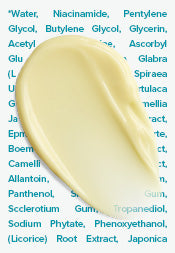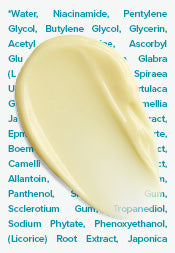The Staple Ingredient of Great Skincare – Hyaluronic Acid
In the world of skincare, ingredient fads come and go. Still, research shows that hyaluronic acid is not just a trend. In fact, it is one of the best skin restoring ingredients you can use to hydrate your skin.
What is Hyaluronic Acid?
First off, hyaluronic acid is a naturally occurring substance in the skin. Specifically, it’s a glycosaminoglycan, a fancy name for a vital naturally occurring substance that’s part of your skin’s youth-supporting matrix. As the chief glycosaminoglycan in skin, hyaluronic acid works to keep every aspect of the skin stable, hydrated, and renewed (2).
Why is Hyaluronic Acid Important?
Hyaluronic acid is integral in formulating good products for your skin because of its stunning capacity to attract and hold up to 1,000 times its weight in moisture. As a humectant, a category of hygroscopic skincare ingredient, they draw moisture from their surroundings. Humectants are often found in water-based moisturizers, serums, and other leave-on skincare products because they help boost hydration for all skin types and are especially beneficial for dry, dehydrated skin.
Hyaluronic acid is also a postbiotic, which is an ingredient that naturally occurs as probiotics found in the skin's microbiome break down. Researchers believe that this synergy with natural skin is another reason hyaluronic acid can strengthen and rebuild the unique microbiome on your skin. Thus, with time and regular application of good products with hyaluronic acid, users can obtain healthier, younger-looking skin.
How does Hyaluronic Acid Work?
So, what exactly does hyaluronic acid do for your skin? Hyaluronic acid has an incredible capacity to enhance moisture content. To give you a more precise understanding, one gram (or 0.03 oz.) of hyaluronic acid can hold up to six litres of water. Talk about mind-blowing!
Even more impressive is that hyaluronic acid can replenish this incredible amount of moisture, all while maintaining balance in the skin. It does not provide the skin with too much water, which can be a problem because excess moisture retention breaks down key substances that normally hold the skin’s surface intact. It also revitalises the skin’s outer surface layers, making it look softer, smoother, and radiantly hydrated. This instantly improves the appearance of fine lines and wrinkles, proving it to be an excellent skin restoring ingredient.
Who should use Hyaluronic Acid?
The good news is that everyone can benefit from incorporating hyaluronic acid skincare like serums, moisturizers or creams as part of their routine. Since it’s a naturally occurring skin substance, it’s suitable for all skin types, including sensitive skin.
Hyaluronic acid’s moisture-binding characteristic is significant in combating skin ageing. When we are young, our skin can hold onto water and retain a balanced amount of moisture, but it gradually loses this ability as we age (3). The result is a visible loss of firmness, increased pliability, and a diminished appearance of plumpness and suppleness (hello, wrinkles).
In Southeast Asia's tropical climate, unprotected sun exposure and environmental assault can also weaken the skin’s surface, leading to premature ageing. While daily usage of broad-spectrum sunscreen and avoiding harsh skin care ingredients is a must for combating these things, hyaluronic acid’s antioxidant and skin replenishing properties go a long way toward mitigating those issues. It’s especially effective when used as part of a complete anti-ageing skincare routine that includes other well-researched ingredients (6). Now that’s what we call a multitasking anti-ageing ingredient.
Sodium Hyaluronate vs Hyaluronic Acid
In addition to hyaluronic acid, you may have seen the similarly named sodium hyaluronate on a skincare product’s ingredient list. Unsurprisingly, these two ingredients are related. After all, sodium hyaluronate is a skin-beneficial salt that’s derived from hyaluronic acid. Sodium hyaluronate possesses similar capabilities as hyaluronic acid but with one extra advantage— because of its lower molecular weight, it is more bioavailable, meaning your skin likely absorbs it more easily than it does with hyaluronic acid.
Does that then mean that sodium hyaluronate is better than hyaluronic acid? No. In fact, Paula’s Choice’s philosophy is that it will be ideal if products such as hyaluronic acid moisturizers and creams contain both of these hydration-boosting ingredients, so your skin can reap the benefits on multiple levels. While some products on the market contain both ingredients, it is more common for sodium hyaluronate to show up in skin care products as hyaluronic acid is more expensive.
Note:
Some companies use what’s called “low molecular weight" hyaluronic acid, which has a smaller molecule size than regular hyaluronic acid (7). Molecules of “regular” hyaluronic acid are larger, which explains why they remain on the skin’s surface. Making hyaluronic acid smaller means it can reach a bit farther into the skin’s uppermost layers for visibly enhanced results.
How to Use Hyaluronic Acid in Your Skincare Routine (when and where to use it)
Now that you know what hyaluronic acid or sodium hyaluronate is and why they can benefit the skin, you might be wondering just how to use them.
At Paula’s Choice Skincare, we’ve incorporated both forms of these hero humectants into our products. You can easily find these research-backed ingredients in our wide array of moisturizer, serum, toner, and face mask formulations. This is because we wantwish to provide you with various ways to add hyaluronic acid to your skincare routine.
In the hyaluronic acid skincare products listed below, the fragrance-free formula also contains redness-reducing, hydrating, and antioxidant ingredients that make skin smooth and soft. They’re also gentle enough even for those with eczema-prone and rosacea-prone skin.
- With a silky, lightweight texture that’s perfect for all skin types, our Hyaluronic Acid Booster is indispensable for its hydrating, line-smoothing formula supported by ceramides to reinforce the skin's natural barrier. Apply directly to the skin after cleansing, toning, and exfoliating, or mix it into your favourite serum or moisturizer for that much-needed moisture boost.
- Those with dry to dehydrated skin will find our RESIST Intensive Repair Cream with Retinol irresistible. With a rich, Retinol-spiked formula, this product is ideal for a daily (and/or nightly) dose of wrinkle-softening hydration supported by sodium hyaluronate, ceramides, and peptides.
- If achieving radiant, glowing skin overnight is one of your skincare goals, you’ll appreciate our Radiance Renewal Mask for its lush gel texture and innovative formula. This skin renewing mask features skin-plumping sodium hyaluronate and other skin restoring ingredients like antioxidants, niacinamide and vitamin C, as well as other extensively researched power ingredients.
- For those struggling with blemishes and are on the hunt for the best moisturizer for acne-prone skin, look no further than our CLEAR Oil-Free Moisturizer. This sheer lotion contains skin replenishing ingredients like sodium hyaluronate, ceramides, and blueberry extract to provide hydration and soothe redness that often comes alongside breakouts.
- Our DEFENSE Nightly Reconditioning Moisturizer prevents premature ageing at the root with a refreshing, made-for-all-skin-types formula that is loaded with antioxidants, superfoods, and sodium hyaluronate that strengthen the skin's defences overnight.
- Don't forget your lips! Our Hyaluronic Acid + Peptide Lip Booster visibly enhances lip fullness thanks to its innovative blend of hyaluronic acid filling spheres. The formulation helps retain water that normally evaporates from within lips, giving you a plump, smooth, youthful, line-free appearance on your lips.
Hyaluronic Acid supplements
What about hyaluronic acid supplements? Does oral intake deliver visible results? A growing body of research says yes, as it turns out that daily oral intake of hyaluronic acid can benefit the skin. Consuming 120-150 milligrams of hyaluronic acid increases skin hydration levels and allows nutrients for the skin to be transported much more quickly. Thus, visibly improving skin elasticity, which complements topical hyaluronic acid's plumping, wrinkle-smoothing results.
Interesting fact:
Our skin’s natural hyaluronic acid content drops as we age. People aged 19 to 47 have twice as much hyaluronic acid in their skin than those in their 50s or 60s. As we move into our 70s, that amount drops even further, making hyaluronic acid supplements even more important, as they help replace what skin loses with time (and, of course, cumulative sun damage hastens this and other skin-ageing processes).
What are the Possible Side Effects of Hyaluronic Acid?
Hyaluronic acid is incredibly gentle and phenomenally helpful for all skin types. It is considered non-irritating as a topical skincare ingredient, with no major side effects reported. Its ability to help regulate the skin’s microbiome can help with redness and sensitivity, while its natural calming abilities also make it suitable for breakout-prone skin (8).
Undeniably, there have been reports of adverse reactions to hyaluronic acid in cases where it is used in dermal fillers. Some side effects included swelling and infection of the skin. However, these cases are considered rare – and are largely unrelated to the topical use of skincare products containing hyaluronic acid or its derivatives (1).
For more information about skincare ingredients beyond hyaluronic acid, please check out Paula’s Choice’s wide array of blogs and articles. Let us guide you in your foray into skincare science and if you require more personal skincare advice, do head over to our Instagram page to contact our experienced staff members. While there may be no easy way to achieve great skin, you can always count on Paula’s Choice to give you the helping hand you need.
Shop highly rated range of Hyaluronic Acid skincare essentials from Paula’s Choice.
References for this information
Advances in Oral and Maxillofacial Surgery, April – June 2021, ePublication
International Journal of Biological Macromolecules, December 2018, pages 1,682-1,695
Clinical, Cosmetic, and Investigational Dermatology, August 2017, pages 311-315
The Journal of Clinical and Aesthetic Dermatology, March 2014, pages 27-29
Journal of Clinical and Aesthetic Dermatology, October 2012, pages 20–23; and March 2009, pages 38–43
Dermato-endocrinology, July 2012, pages 253–258
Journal of Drugs in Dermatology, September 2011, pages 990–1000
International Journal of Toxicology, July–August 2009, pages 5–67












